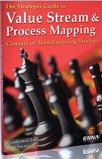Anthony V. Element (Australia)
Electric Motors
Sorry to be critical, but your argument that 5S benefits are difficult to quantify is
fundamentally flawed.
First, you are making the mistake of addressing 5S in isolation. When Taichii Ohno developed
the suite of concepts that make up LE for Toyota, he was adamant that they all worked together,
harmoniously. You simply cannot discuss any aspect of LE in isolation.
In terms of relevant figures, here's one example that relates directly to the link between 5S
and throughput. Some years ago I was General Manager of an electric motor manufacturer in
Australia. We had begun introducing LE with company wide training on:
The factory workers response for the most part was, "We know the Chinese will have our jobs
someday but this is the first time we've felt like we could fight back. We'll give it a go."
We then implemented 5S thoroughly, i.e. each S got a good going over right across the company
, (that means offices and factory.) The staff decided to pile it all up in the car park so we
could viscerally sense that we were doing something significant. Much hilarity about the size of
the mountain that ensued.
Anyway, the C Frame production people suddenly discovered the distance they were traveling
because now that the clutter was gone the space they traversed between work centres, tool
boards, parts racks, etc., was made obvious by the emptiness. Before we'd gotten around to
actually having a kaizen, they moved all the machines, tools, and parts together. Doing nothing
else resulted in:
-
Utilised space reduction of 62%;
-
Daily distance walked reduction from 1+ kilometers to <100metres,
-
Output improved by >20% with the same headcount.
All this and we hadn't yet done a kaizen event.
We had a pizza lunch to celebrate and that was when the real benefit came out. One of the C
Frame team said, as best as I can remember: "If we can make this much improvement from nothing
more than a big Spring clean, what's going to happen when we've done all this LE (expletive
deleted)."
That was several years ago and the factory's still there. Although the products aren't as
cheap as imports, production can turn on a dime in response to customer requirement changes, and
that the Chinese can't do without a local warehouse which eats their price advantage.
Hope that helps. Cheers,
Michel E. Hess (U.S.)
Financial Call Center
"In our call center operation, 5S eliminates distractions, promotes consistency and reduces
wasted motion. It greatly enhanced our office rearrangement and helped our conversion to
paperless processing."
|
Brian Levitan (Australia)
I disagree that the benefits of 5S are hard to quantify. Here are some examples:
Roll Forming
-
Accidents LTI and MTI 50-70%
reduction
-
Space Saved 20%-40%
-
Morale/ Absenteeism- drop of 25% -
50%
-
Productivity/Quality- improvements
of 15- 50%
-
The results were obtained after
years of conventional methods and committees and HR surveys which did not produce results.
-
Reverse Logistics Stores
-
Improvement in productivity of 15%.
Welding Wire Plant
After a 5S Blitz on a steel slitting line (3 day event because of the culture change) there
was a huge improvement in quality. This impacted favorably on the downstream downtime of the
wire lines, thus a huge improvement in OEE resulting from an improvement in quality from an
upstream process. Yet, the focus was on culture change and not quality itself.
Americo Chiruque (Mozambique)
Basic Metals
After reading this article, I felt that it could raise a very interesting debate, especially
amongst those who are (or have been) part of a 5S implementation team.
When we started the 5S implementation at Mozal in 2003, this was one of the questions put and
although the importance of the initiative was clear to us, it was not easy to give a sort of a
mathematical answer to it.
Now, about three years down the line, we can feel that 5S is a pre-requisite for creation of
a high performance culture in the organisation as it helps to establish the basics. I tend to
believe that no one can achieve big accomplishments without being able to do small things.
Last month I received a safety report that was making a correlation between HSE audit
findings and 5S audit findings and the conclusion was the following:
-
The main category of safety and environment problems is 5S related problems;
-
All the departments that have poor performance on 5S are also poor performers on safety
and environment ;
-
The best 5S areas are also best areas in terms of safety and environment.
It is possible to extend this analysis to other correlations such as quality of 5S versus
productivity, etc. This is because the key for good safety performance is discipline and
appropriate behaviour.

|





